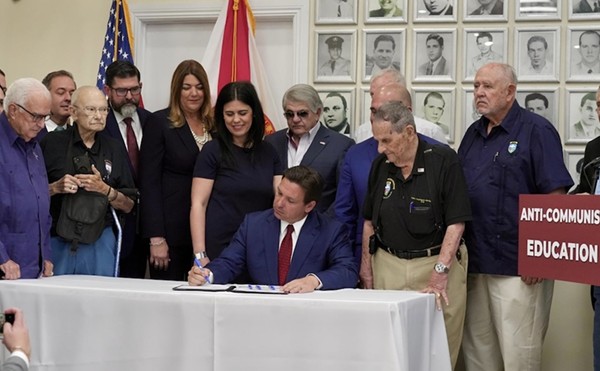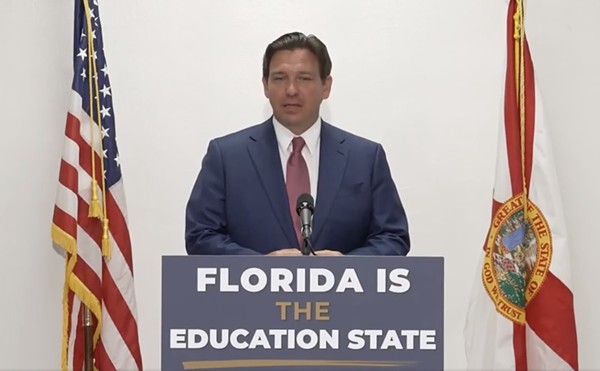AJ Gallant looks like a mean son-of-a-bitch. It's partly his barrel chest, his hefty arms, dotted with tribal tattoos, and the long ponytail pulled taut, leaving the shaved sides of his head exposed, but it's his eyes that do the trick. Their near-bloodshot, glossed-over gaze when opened wide – and they almost always are – is frightening.
This trait is a good thing to have in the professional wrestling business, and the 36-year-old Gallant uses it well. He spent years wrestling under the name "Viper" before stepping out of the ring due to an injury. But in August 2004, after a few years as a guitarist for local band Blindfold, he stepped back into pro wrestling – this time opening Federation X Entertainment, a school in Orlando for would-be wrestlers who wanted to learn the sport, or the show or … what is professional wrestling exactly?
For Gallant, it's old-fashioned storytelling, though not in the traditional sense. Body slams and hip throws populate these stories, where good guys and bad guys battle it out because there's history – a bad guy dissed a good guy or one wrestler mouthed off to another – and a need for retribution. This is wrestling as masculine soap opera.
Gallant's school is a full-sized ring in a garage bay sandwiched in a row of industrial buildings off Orange Avenue. Exposed beams make up the nearly 20-foot-high ceiling, and the floor is chipped concrete.
Tonight, a Wednesday, Gallant is standing outside the garage watching 10 students warm up. Larry Brannon, president of operations for FXE (Gallant is the CEO) and known in wrestling circles as Vito DeNucci, is making sure the 10 finish a final set of 50 squats, 25 push-ups, 25 sit-ups and 25 jumping jacks. Brannon, sporting a Chicago White Sox hat, banters with Tom Lawlor, a 22-year-old who recently graduated from UCF, where he won three straight National Collegiate Wrestling Association titles.
"Are those jumping jacks?" Brannon asks as Lawlor swings his arms in the air.
"Go Astros," Lawlor replies, a reference to the World Series between the White Sox and the Astros.
Brannon laughs. "Go Astros? Fuck you."
The group filters into the garage, and two by two they step into the ring for drills. Right away it's loud. The concrete floor has a little give to it, but it also makes a crashing sound with every footstep, like a fat guy running across an old hardwood floor. Pairs of wrestlers start by taking a "bump," which means throwing yourself backward onto the ring floor while getting hit with a forearm. The technique is in the fall, not the hit, and wrestlers often practice taking bumps without anyone ever touching them. Throughout the night, students crouch in the ring and then throw themselves backward, landing flat on their backs with legs in the air.
The paired wrestlers have a set routine for the bumping drill. Lawlor and Nikki Ford – one of two female students – step into the ring. Ford throws Lawlor across the ring and into the corner. Lawlor feigns pain and struggles to stay standing while Ford bounces around the ring. She finally slingshots herself off the ropes toward Lawlor, but he has recovered (miraculous!) and throws a forearm at her shoulder. She flies back onto the mat. BANG! Lawlor picks her up by the hair and wipes his nose with disgust. The students outside the ring boo. Someone yells, "You know, they've got roofies for that!"
There are a few laughs, but Lawlor isn't fazed. In this drill he's the bad guy, or the "heel" in wrestling terms, and Ford is the good guy, or "baby face." Lawlor looks at the crowd of other students and snarls. He licks his lips, then throws Ford around the ring.
If a match is wrestled correctly there won't be a lot of pain. No one is really doing anything to anyone else; they're equal partners in whatever action takes place, like the hip toss, where one wrestler does a somersault over the other's knee. Both have to work in tandem to make the move convincing. Ford runs at Lawlor, who has his leg sticking out. She connects arms with Lawlor and then jumps, twirling forward, and lands on her back on the other side of his knee. In real time, it looks painful. In slow motion it's more like a dance, with both partners watching their steps, making sure the other is where he or she needs to be. Ford continues to lose this match until she finally forearms a running Lawlor, who now himself smacks flat onto the ring floor. BANG! The crowd cheers.
They finally step out of the ring.
"That was good," Brannon says to Lawlor. "You two needed a little help on your hip tosses, but you sold that character."
SCHOOL OF KNOCK
Gallant attended a wrestling school in Ocoee when he was younger. The technical training was OK, but when he went to see his teacher at a match, he thought, "This guy is corny. How am I going to learn from him?"
Gallant wants his students to learn both the technical and the character-development side of wrestling. He has a black three-ring binder at home with "FXE" on the front. In it is page after page of potential wrestling characters. He works with students on their characters. Are you a baby face or a heel? What's your character's history? Why is your character mad all the time? It's Acting 101. There's no soap opera without actors.
There's Paul Reyes, a young Hispanic student, known as "Jalapeño Montana III." When Reyes is in character he pronounces "the third" in a thick Mexican accent: "da turd." It makes people laugh, which, Gallant says, is good for a baby-face character. There's Shane Hartline, a 19-year-old student with curly blond hair, known as "Rip Malibu," a baby-face wrestler with a persona that screams, "No waaay, dude!" Then there's Michael Jarvi, a 6-foot, 11-inch, 305-pound 22-year-old with wavy black hair to his chin. "Tower," as he's called in the wrestling world, is a heel for sure.
Gallant tells his students they have to believe in their characters, have to become them, have to create a story that keeps fans coming back. Fans have not been coming back as much lately, he says, at least not to the big shows. World Wrestling Entertain-ment is the big stage for wrestlers, but crowd sizes have been down in the past few years. The violence is at an all-time high, but body slams and hip tosses are only tools to tell the story. If the story isn't good, it doesn't matter how good the wrestling is.
One recent story line in the WWE had the supposedly pregnant girlfriend of a wrestler being thrown down by another wrestler. The action resulted in a staged miscarriage. Gallant thought that went too far. Then there was the wrestler named Muhammad Hassan, an Arab-American whose character would spew anti-American rhetoric. Hassan was finally pulled after numerous complaints from anti-discriminatory groups and hard-core WWE fans alike.
"Having a miscarriage or a bigot character on your show is not good story," Gallant says. "How is that fun? It's not fun. How's that entertainment? It's not."
To him, wrestling is about good versus evil.
With the nearly 7-foot-tall Jarvi, a heel in the ring, the trick is to have him win enough against baby-face wrestlers to piss off the crowd so that they'll keep coming back, hoping to see Jarvi lose. "It's basic stuff," Gallant says. "You have the heel beat up on the baby face for a while before the baby face comes back and wins. It's Rocky-type of stuff."
It seems at first to border on pomposity for FXE to have a CEO, a president of operations and a vice president of operations. This isn't a Fortune 500 company. Why not just call themselves business partners? But Gallant and Brannon take this seriously.
"AJ and I talk for almost two hours every day," says Brannon. "We'll talk about what's working, what's not, where this thing could get better. Sometimes AJ will call late at night and say, 'What do you think about this?' and I'll say, 'I think you need an effing life!'"
The main theme when talking with the students is to let them know that the school is for real. Most of the 27 enrollees have wrestled in matches for any number of acronym-heavy wrestling organizations: the CWA, FWF, SGWA, SCW, PWWF. And many of them started at other schools before coming here. Ricky Vega, 28, came from New York, where he attended WWE Hall-of-Famer Johnny Rodz's training school. He says the training he receives here is nearly identical to what he received in Manhattan.
"I opened this school to train these kids right," Gallant says. "We're serious about this."
He must be serious; he's hired a public relations firm, and production companies in Los Angeles have shown interest in a reality show about FXE. This soap opera could hit the airwaves someday.
On Thursday, a busier night, more than 20 students show up. Gallant is helping them practice their promos, which are short interviews while in character. Gallant sits in a chair and counts down for everyone. "Three, two, one." Then an announcer (one of the students) begins an interview. Jay Pulinka, or as he's known in the ring, "JP Ace," stands next to the ring with a small stuffed figure (standing in for a microphone) shoved in his face. Pulinka's bald head glistens with sweat and his voice lowers, adding a gruffness not normally present.
"Do I look like I care if I win or lose?" Pulinka says in response to a question. His hands gesture sharply; his eyes focus intensely on the imaginary camera in front of him. "All I care about is inflicting pain." Gallant's own eyes widen a bit, and he strokes his goatee absent-mindedly. He looks like a kid, lost for a moment in the story.
The announcer inquires again about how Pulinka will do in this imaginary match.
"Listen, I'm going home with a big L, and he's going home in a body bag."
Everyone laughs. "Don't you mean 'a big W'?" Gallant asks. "You're going home with a win, not a loss. It's all right. It was good. You're learning."
During practice one night, Brannon stops everyone to preach about the importance of character. He takes 20 minutes to teach how to look around at the crowd, how to take small pauses during the match/performance to glower at your opponent while he's down. There is as much instruction on how to pump up the crowd as there is on how to pummel the opponent.
"It's a roller coaster," Gallant says. "You take the crowd here." He raises his flat hand as if indicating someone's height. "Then you plateau. Then you take them here," and he raises his hand higher. "Then you plateau, then you shoot them off and the crowd goes wild. That's when they'll come back for more, to see those characters again."
[email protected]


















